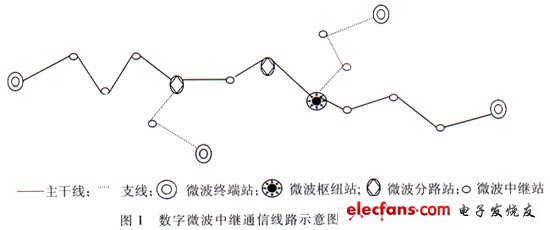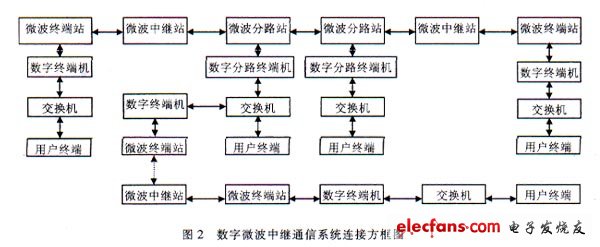Microwave communication is a new generation digital microwave transmission system. Digital microwave communication is a communication method that uses microwaves as a carrier to transmit digital information. It has the advantages of both digital communication and microwave communication. Due to the characteristics of microwave transmission in space, this communication method is also called line-of-sight digital microwave relay communication.
1. Composition of digital microwave communication system
The composition of the digital microwave transmission line can be a main line with several branches in the middle, or it can be a hub station branching in several directions. As shown in Figure 1, it is a schematic diagram of a digital microwave communication line. Its trunk line can be up to several thousand kilometers, and there are several branch lines. In addition to the terminal stations at both ends of the line, there are a large number of relay stations and branch stations to form a Digital microwave relay communication line.

The connection block diagram of this communication line device is shown in Figure 2. It is divided into the following parts:

A user terminal is a terminal device directly used by a user, such as an automatic telephone, a fax machine, a computer, and a dispatch telephone.
switch. This is a device used for the temporary combination of functional units, channels or circuits to ensure the required communication actions. Users can make call connections through the exchange to establish temporary communication channels or circuits. This exchange can be either analog or digital. At present, most large-capacity trunk lines use digital program-controlled switches.
Digital telephone terminal multiplexing equipment (ie digital terminal). Its basic function is to convert multiple signals from the switch into time-division multiplex digital signals and send them to the digital microwave transmission channel, and to inversely convert the time-multiplex digital signals received by the digital microwave transmission channel into the signals required by the switch and send To the switch. For the PDH system, coded modulation digital telephone terminals are generally used. It also includes secondary group and high-order group multiplexers, security machines and other digital interface devices. Depending on the nature of the work, it can form a digital terminal or a digital branch terminal. For the SDH system, SDH digital multiplexing equipment, or SDH equipment for short, is used. It consists of some basic functional blocks to flexibly form different types of total equipment. The digital branch terminal in the figure can be replaced by an add-drop multiplexer (ADM).
Microwave station. According to different working nature, it can be divided into digital microwave terminal station, digital microwave relay station and digital microwave branch station. Microwave stations with more than two directions up and down the road are called digital microwave hub stations. The transmitter of the SDH microwave terminal station completes the baseband processing of the main signal (including CMI / NRZ conversion, SDH overhead insertion and extraction, microwave frame overhead insertion and bypass service extraction, etc.), modulation (including error correction coding, Scrambling code and transmission differential coding, etc.), transmission mixing and transmission power amplification, etc .; the receiving end of the terminal station completes the low-noise reception of the main signal (including diversity reception and diversity integration as required), demodulation (including IF frequency domain equalization, baseband or IF time domain equalization, receiving differential decoding, descrambling codes, error correction decoding, etc.), receiving baseband processing (including bypass service extraction, microwave frame overhead insertion and extraction DH Overhead insertion and extraction, NRZ / CMI conversion, etc.). In terms of official communication, the terminal station has both full-line official services and station-selected official services. In terms of network management, the terminal station can be set as the network management master station or master station through software, collect the information reported by each station, monitor the line operation quality, perform network management system configuration management, remote control, and telemetry commands. The interface is connected to the telecommunication management network (TMN). The base station interface of the terminal station is connected to the SDH multiplexing equipment, and is used for upper and lower low-cost branch signals. The terminal station also has a backup switching function, including the identification of the switching reference, the sending and receiving of switching commands, and the start and confirmation of switching actions.
Digital microwave relay station. Mainly complete the bidirectional reception and forwarding of signals. Relay stations with modulation and demodulation equipment are called regenerative relay stations. The relay station that needs the upper and lower voice channels is called a microwave branch station, and it must be connected to the SDH add-drop multiplexing equipment. The regenerative relay station has full-line official communication capabilities and reports station information to the network management system. The ability of line operation quality, and can perform configuration management of network management system and perform remote control and telemetry. The regenerative relay station can also bypass the service signal up and down.
Spool Of Christmas Lights,Spool Of Led Lights,Led Spool,Spool Of Led Christmas Lights
DONGGUAN JIANXING LIGHTING ELECTRIC APPLIANCES CO., LTD , https://www.rslightstring.com